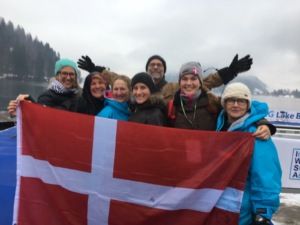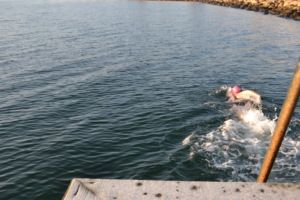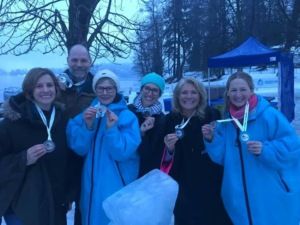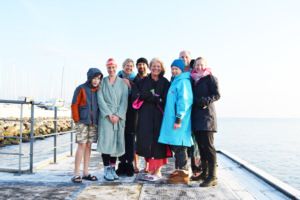News
The big chill: Saluting the expat swimmers who came good in the cold
This article is more than 6 years old.
Team Denmark – a group of seven amateur ice swimmers from the UK, South Africa and the US – brings home to Copenhagen 15 medals after competing at the 2019 Winter Swimming World Cup in Bled, Slovenia
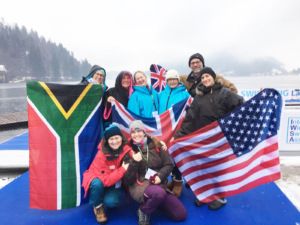
It was too cold for a selfie in Slovenia, but they managed to smile!
When you enter four-degree Celsius water, you cannot say right away if it is very hot or very cold. It is just burning your body.”
In Slovenia, Lindy Thorburn and her team-mates were not competing against the others, rather against ice-cold open water, frightening weather conditions and their own minds.
It was pouring down and windy, causing the kinds of waves that ice-swimmers dread. Visibility was low; snow was covering the edges of the partly frozen lake.
In such extreme conditions, the fearless ice-swimmers representing Team Denmark needed to remind themselves to breathe. Only a few months ago, they didn’t have the faintest idea they would be taking part in the international ice-swimming event together with nearly 120 swimmers from 26 countries.
“The Russians were by far the most represented country,” the ladies recall, laughing heartily. “No wonder!”
Outside the comfort zone
For Thorburn, Jane Upward, Margaret Gadzic, Karin Mattioli and Karren Probyn, it all started when they moved to Denmark with their families and spotted how the Danes enjoy ice-cold skinny dipping.
After carefully observing the natives, they gave in to the urge to purify themselves in the freezing cold waters of the Øresund.
They all attended a pep talk given by Mette BL Thomsen, a Danish ice-swimming champion who draws from the tragic loss of her mother as a child an extraordinary motivation to overcome her psychological limits and fears – a calling that gives meaning to her existence as she leaves her comfort zone.
“We were all so inspired that we couldn’t wait to enter an international ice-swimming competition,” recalled Sue Allingham, a swimming coach at Gentofte Municipality’s swim school for the past ten years, who encourages non-swimmers to compete in open-water swims, triathlons and now ice-swims.
A shot at world glory
Long and gloomy winters encourage mindfulness and the need to take on personal challenges and, before they knew it, the group of expat moms in their 40s and early 50s had signed up for the extreme challenge. They represented a wide range of levels, from Gadzic the competitive swimmer to Probyn the newbie who joined Allingham’s swim team last autumn. As Thorburn pointed out: “How many opportunities do you get in a lifetime to participate in a World Cup?”
Thorburn remembers making quick progress, and by Christmas she was able to swim 50 metres. “The sauna is the treat afterwards,” she revealed. The heated, small wooden room enables the body to return to its usual temperature in no time.
Gadzic even brought along her 11-year-old son Danny to join in the ‘Polar bear’ plunge. “He was the only kiddo and he didn’t hesitate,” his proud mom recalled.
The first big test
Things took a serious turn in the New Year when the newly-formed team swapped Charlottenlund Søbad for Skovshoved, the harbour located between Charlottenlund and Klampenborg.
On a freezing Sunday morning in mid-January, an extraordinary act of courage occurred. Out into the wild sea where swimmers can’t touch the bottom, off they went one by one for their 50-metre ice-swim while nearby overdressed children were trying to crack puddle ice.
Even passers-by could feel the intensity of the challenge these self-proclaimed ice-swimmers had undertaken. And with no sauna around, their shivering went on for an hour or so after they exited the 0.5-degree water.
Catharina’s catharsis
Peter Høgdal and his 23-year-old daughter Catharina joined them to provide insightful first-hand race tips.
“Catharina gave such a moving and awe-inspiring talk that she furthered the girls’ ambitions as to how far they really could swim in cold water,” recalled Allingham.
Daily swims in the ice-cold water had miraculously cured the young Dane from knees so bad that she couldn’t stand on her own two legs and needed to be carried from one classroom to another. Five years ago in despair, her parents decided to take her for a swim in the sea. In the water she could finally move freely – for the first time in ages. The cold shock response broke her cycle of pain.
Catharina can now lead a normal life and even jog from time to time. Ever since, father and daughter can be seen swimming their 6 am daily 600 to 800m swim at Svanemøllen all-year round, and on occasion they compete internationally.
Sackful of medals
Day after day filled with training and research, confidence grew within the team to the point that they all signed up for longer distances and more technical races at Bled, including the 100 metres and the butterfly.
Leading the medal haul was Gadzic with three: the 25m freestyle bronze, 25m breaststroke relay silver, and 25m butterfly bronze – a tally matched by Upward with the 100m freestyle silver, 50m freestyle silver and 25m freestyle silver.
While Karren Probyn, her husband Mark, Mattioli and Thorburn all took two each.
Veni, vidi, vici. Three days later, they were on their way back from Slovenia full of glory and inspired to go beyond.
Among the elite
“I love meeting people who consistently choose to put their bodies through seemingly crazy ordeals. And then I get to the realisation that of course I can do it too,” enthused Upward, who cites as an inspiration Wim Hof – aka the Iceman – who is notable for his ability to endure extreme cold thanks to his Wim Hof Method breathing techniques.
“You become part of the ice-swimming family once you take part. We’ve met world record breakers and marathon ice-swimmers. The go-getters and anything-is-possible people.”
Upward has a picture of herself with Christof ‘Wandi’ Wandratsch, the German long-distance swimmer who set the record for the fastest ever crossing of the English Channel in a time of seven hours and three minutes in 2005.
And another picture shows her hugging Jaimie Monahan, who completed in 2017 the first documented Ice Sevens Challenge in history by swimming an ‘Ice Mile’ (1.6 km in a water temperature of below five degrees) with no wetsuit nor neoprene hat on all seven continents.
Chile’s Barbara Hernandez was also among the competitors. Nicknamed ‘The Ice Mermaid’ in Chile, she was the first woman to swim in extreme temperature glaciers without a wetsuit on the Northern Ice Cap. Pictures of her swimming in the San Rafael Glacier or Perito Moreno while the glaciers are calving are breathtaking.
When they are not swimming or breaking new records, Monahan works full-time as a campus recruiting lead for Deloitte in New York and Hernandez as a psychologist back home.
Next up: Siberia
Thorburn, Upward, Gadzic, Mattioli and Probyn have now befriended these modern-day explorers on Facebook and are already planning to meet again for the next challenge – perhaps in Tyumen, Siberia in December, where the water temperature will be zero and the air temperature -30.
Endurance swimming is not just a battle to the finish line, but a fight to stay alive with an intensive care unit on site. Dizziness, disorientation, hallucinations and amnesia are symptoms a long-distance ice-swimmer learns to recognise and then exit the water at once.
As Thorburn concluded: “I think I’m hooked.”

